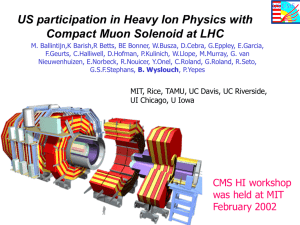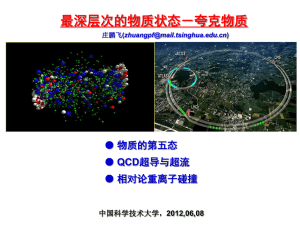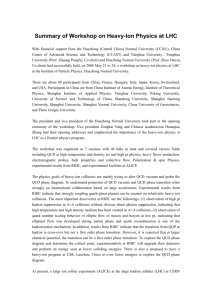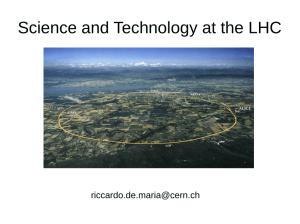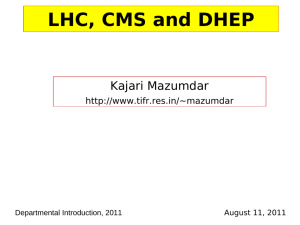LHC - Indico
advertisement
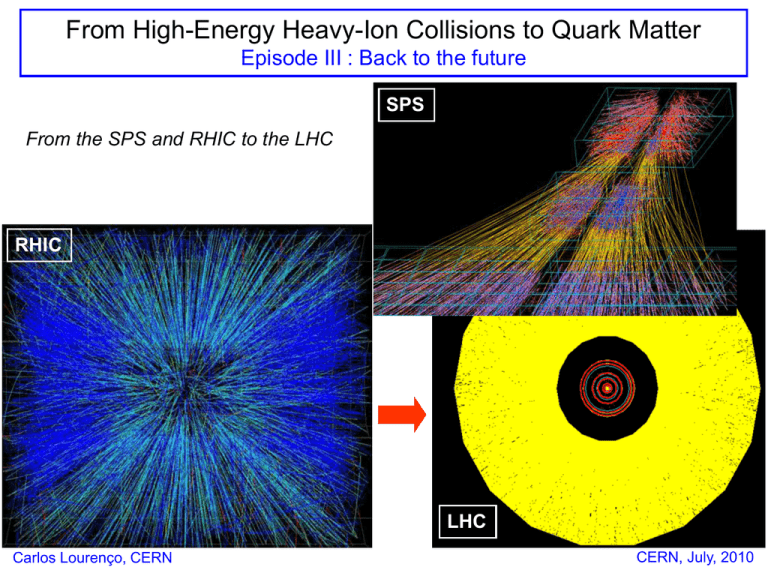
From High-Energy Heavy-Ion Collisions to Quark Matter Episode III : Back to the future SPS From the SPS and RHIC to the LHC RHIC LHC Carlos Lourenço, CERN CERN, July, 2010 1 QGP physics from SPS to RHIC • SPS : 1986 – 2003 : Pb-Pb and In-In at s = 20 GeV J/y and y’ (and cc ?) suppression deconfinement thermal dimuon production thermal QCD medium compelling evidence for a “new state of matter” with “QGP-like properties” • RHIC : 2000 – ?? : Au-Au at s = 200 GeV jet quenching: parton energy loss very dense QCD medium baryon/meson elliptical flow scaling partonic degrees of freedom compelling evidence for a strongly-coupled QGP (the “perfect fluid”) 2 “Quark soup” and “perfect fluids” RHIC’s Quark Soup is made of “liquid stuff” Black holes and perfect fluids in physics today 3 The “perfect fluid” found at RHIC M. Roirdan and W. Zajc, Scientific American, May 2006 4 The “perfect fluid” in the press When physicists talk about a perfect liquid, they don’t mean the best glass of champagne they ever tasted. The word “perfect” refers to the liquid’s viscosity… A perfect liquid has no viscosity at all, which is impossible in reality but useful for theoretical discussions… material swallowed by black holes might also have extremely low viscosity… 5 QGP physics from SPS / RHIC to the LHC • LHC : 2010 – ?? : Pb-Pb at s = 2750 GeV (and 5500 GeV later on) confirm interpretation of SPS & RHIC results by testing new predictions explore & understand high-density QCD properties with original measurements heavy quarks (charm, beauty), jets, upsilons is the initial state at the LHC yet another state of matter ? colour glass condensate ? (QCD in the classical field theory limit) transition from a strongly coupled QGP to an ideal QGP ? surprises ? more puzzles ? what will little Alice find behind the curtain ? 6 One small step for a man, a giant leap for mankind… SPS RHIC LHC √sNN (GeV) 17 200 dNch/dy 500 850 1500-4000 t0QGP (fm/c) 1 0.2 0.1 T/Tc 1.1 1.9 3-4 Hotter e (GeV/fm3) 3 5 15-60 Denser tQGP (fm/c) ≤2 2-4 ≥10 5500 [ 2750 in 2010 ] Longer tf (fm/c) ~10 20-30 30-40 Vf (fm3) few 103 few 104 few 105 Bigger The LHC is a giant leap forward in QGP physics, well beyond previous facilities 7 LHC “nominal” running parameters Collision system √sNN (TeV) L0 (cm-2s-1) pp 14 1034 Pb-Pb 5.5 1027 p-Pb 8.8 1029 Ar-Ar 6.3 1029 <L>/L0 (%) Run time (s/year) 107 50 106 106 65 106 Expected integrated luminosity in a typical Pb-Pb run : Lint (Pb-Pb) ~ 0.5 nb-1/year The LHC is expected to run “heavy-ions” for around 1 month each year 8 Hard Probes of QCD matter at LHC energies • Very large cross sections at the LHC pp s = 5.5 TeV • Pb-Pb instant. luminosity: 1027 cm-2s-1 • ∫ L dt = 0.5 1 mb nb-1 (1 month, 50% running efficiency) J/y • Hard cross sections: Pb-Pb = A2 x pp pp-equivalent ∫ L dt = 20 pb-1 1 nb h+/h- 1 event limit at 0.05 pb (pp equiv.) g*+jet Note: one Pb-Pb collision is roughly equivalent to 40 000 pp collisions… jet Z0+jet 1 pb gprompt 1 event 9 Solenoid magnet 0.5 T ALICE Forward detectors Specialized detectors: • HMPID • PHOS Central tracking system: • ITS • TPC • TRD • TOF Muon spectrometer: • absorbers • tracking stations • trigger chambers • dipole 10 A global view of the ALICE experiment • Covers very low-pT (~ 100 MeV/c) and high-pT (> 100 GeV/c) • Has particle identification over a large momentum range • Is able to handle large charged particle multiplicities • Will measure open charm, beauty, direct photons, J/y, etc 11 The ALICE TPC Readout chambers Largest TPC ever 88 m3, 570k channels 90% Ne – 10% CO2 Field cage End plate HV membrane 2/19/2007 Raimond.Snellings@nikhef.nl 12 Other ALICE detectors Silicon drift TRD Silicon pixels TOF Muon slats ZDC PHOS PbWO4 crystals 13 ALICE had its first detector upgrade already Lead-scintillator sampling calorimeter Shashlik fiber geometry Avalanche photodiode readout Coverage: | | < 0.7, = 110° ~13k towers ( x ~ 0.014 x 0.014) Design resolution: E/E ~ 1% + 0.08/√E The first EMCal modules were installed in March 2009 between the magnet and the “space frame” that holds the TPC and other central detectors 14 ATLAS will also study QGP physics with Pb-Pb collisions • ATLAS is fully operational • Extensive preparations for the Pb-Pb program show a promising performance 15 ATLAS will measure jets in Pb-Pb collisions Fragmentation function: D(z) ATLAS simulation ATLAS simulation Reliable reconstruction of D(z): Reconstructed tracks with pT > 2 GeV matching calorimeter jets Comparing PYTHIA to PYQUEN gives the scale of possible modifications of the fragmentation function in Pb-Pb ATLAS can measure jet quenching of the size simulated by PYQUEN 16 Inclusive jet production in pp collisions Observed inclusive jet multiplicity distribution (top left) Inclusive pT distribution for jets with pT > 30 GeV and |y|< 2.8 (top right) Jet‐jet mass distributions (left) Data compared to PYTHIA Monte Carlo calculations (yellow histogram) 17 A global view of the CMS experiment 18 Phase space coverage of the CMS detector CMS + TOTEM: full φ and almost full η acceptance at the LHC charged tracks and muons: |η| < 2.5 electrons and photons: |η| < 3 jets, energy flow: |η| < 6.7 (plus η > 8.3 for neutrals, with the ZDC) excellent granularity HF h = -8 -6 -4 -2 and resolution very powerful High-Level-Trigger HF 0 2 4 6 8 19 h±, e±, g, m± measurement in the CMS barrel (|h| < 2.5) Si Tracker + ECAL + muon-chambers Si Tracker Calorimeters Muon Barrel Silicon micro-strips and pixels ECAL HCAL Drift Tube Chambers (DT) Resistive Plate Chambers (RPC) PbWO4 Plastic Sci/Steel sandwich 20 Charm and beauty yields vs. energy and collision system Charm cross section at the LHC is higher Including EKS98 shadowing by a factor ~ 10 w.r.t. RHIC energies and SPS RHIC LHC LHC LHC by a factor ~ 1000 w.r.t. SPS energies: central central pp p-Pb central pp • s = 20 GeV scc ~ 5 mb Pb-Pb Au-Au Pb-Pb N(cc)/event 0.2 10 0.16 0.8 115 • s = 200 GeV sccpp ~ 600 mb -0.05 0.006 0.03 4.6 • s = 5.5 TeV sccpp ~ 6600 mb N(bb)/event Abundance of charm production at the LHC will enable detailed studies of several topics, including charm thermalisation The detection of D and B mesons requires an accurate determination of the collision vertex and of the distance between the extrapolated charged tracks and the vertex Typical impact parameters: a few 100 mm for D decays and ~500 mm for B mesons 21 Heavy flavour production at LHC energies Initial state effects: Heavy Quark energy loss: Nuclear shadowing suppresses low-pT heavy flavoured particles in p-A and A-A collisions: ~ 20% reduction of beauty production and ~ 40% reduction of charm (EKS98) Parton energy loss is expected to occur by: • medium-induced gluon radiation • collisions in the medium It is expected to depend on the properties of the medium (length, energy density, etc.) DE (L, eQGP) Pb-Pb / pp and also on the quark mass s = 5.5 TeV beauty We will probe heavy quark energy loss through ratios of pT distributions, between Pb-Pb and pp, between B and D mesons, etc charm We will also do these studies using jets tagged by the presence of D or B mesons 22 Quarkonia studies in ALICE with dimuons Pb-Pb simulation J/y Y Y’, Y’’ After background subtraction Rapidity window: 2.4–4.0 Mass resolution: 70 MeV at the J/y 100 MeV at the Y Mmm (GeV/c2) pp data ! ALICE has been collecting pp collisions at 7 TeV and has already seen a J/y peak in the dimuon channel dimuon mass resolution : 80 – 90 MeV Figure shown at the LHCC meeting, at CERN, on Wednesday, July 7, 2010 23 Quarkonia studies in ALICE with electron-positron pairs Combining the ITS, TPC and TRD data, available for |h| < 0.9, ALICE can access vertexing information for the electrons Pb-Pb simulation Good mass resolution, ~50 MeV, due to the low material budget of ALICE, which was measured with photon conversions pp data Figures shown at the LHCC meeting, at CERN, on Wednesday, July 7, 2010 24 Tomography of the CMS and ATLAS inner detectors Figures shown at the LHCC meeting, at CERN, on Wednesday, July 7, 2010 25 Quarkonia studies have also started in CMS and ATLAS J/y + continuum pp data events / 20 MeV full rapidity all muons In CMS, it is ~40 MeV integrating the full rapidity coverage and ~20 MeV at mid-rapidity mass resolution = 43 MeV J/y + continuum continuum central rapidity golden muons pp data events / 80 MeV continuum The good mass resolution results from the matching of the muon tracks to the tracks in the silicon tracker pp data mass resolution = 21 MeV Figures shown at the LHCC meeting, at CERN, on Wednesday, July 7, 2010 26 Measuring beauty yields from displaced J/y production entries / event prompt J/y J/y from B prompt J/y J/y from B simulation J/y m+m- simulation J/y e+e- vtr (mm) Many of the J/y mesons observed at the LHC come from decays of B mesons They can be separated from the “prompt” J/y mesons because they are produced away from the collision vertex 27 A decay of a B meson to J/y + K seen in CMS CMS experiment at LHC, CERN Run 136100 / Event 256858438 2010-25-5 03:43:48 CEDT secondary vertex B- → J/y K- candidate primary vertex Figures shown at the LHCC meeting, at CERN, on Wednesday, July 7, 2010 28 Wake up! we are almost finished… Oh my God… Dear Dalai Lama… 29 studies in CMS J/y Upsilons have been simulated in Pb-Pb collisions… and already measured in pp collisions ! (1S) y’ Pb-Pb @ 5.5 TeV dNch/dh = 3500 m+mFigure shown at the LHCC meeting, at CERN, on Wednesday, July 7, 2010 30 Expected pT reach of quarkonia measurements in Pb-Pb ● produced in 0.5 nb-1 ■ rec. if dN/dh ~ 2500 ○ rec. if dN/dh ~ 5000 J/y 0.5 nb-1 : 1 month at 4x1026 cm2s-1 Expected rec. quarkonia yields: J/y : ~ 180 000 : ~ 26 000 Pb-Pb Pb-Pb at 5.5 TeV design luminosity CMS simulation Statistical accuracy (with HLT) of ’ / ratio vs. pT should be good enough to rule out some models Similar low pT yields for J/y and with HLT 31 The CMS High Level Trigger • CMS High Level Trigger: 12 000 CPUs of 1.8 GHz ~ 50 Tflops ! • Executes “offline-like” algorithms • pp design luminosity L1 trigger rate: 100 kHz • Pb-Pb collision rate: 3 kHz (peak = 8 kHz) pp L1 trigger rate > Pb-Pb collision rate run HLT codes on all Pb-Pb events • Pb-Pb event size: ~2.5 MB (up to ~9 MB) • Data storage bandwidth: 225 MB/s 10–100 Pb-Pb events / second • HLT reduction factor: 3000 Hz → 100 Hz • Average HLT time budget per event: ~4 s Pb-Pb at 5.5 TeV design luminosity ET reach x2 jets x30 x30 • Using the HLT, we can keep all the interesting events (hard processes) and reduce by a factor around 30 the more common events 32 Impact of the HLT on the pT reach of RAA Nuclear modification factor = “QCD medium” / “QCD vacuum” Pb-Pb 0.5 nb-1 Pb-Pb 0.5 nb-1 HLT CMS simulation Important measurement to compare with parton energy loss models and derive the initial parton density, dNg/dy, and the medium “transport coefficient” 33 Jet ET reach and fragmentation functions Jet spectra up to ET ~ 500 GeV (Pb-Pb, 0.5 nb-1, HLT-triggered) Detailed studies of medium-modified (quenched) jet fragmentation functions Gluon radiation: large angle (out-of-cone) vs. small angle emission CMS simulation HLT 34 g, g* and Z tagging of jet production photon or Z The dense QCD medium redistributes the initial parton energy, Ejet, in the hadron jet This redistribution is measured in the Fragmentation Function… if we know Ejet But it is very difficult to access Ejet in HI collisions, because of the medium modifications… g away side g* jet (hadrons) Sometimes, the parton that fragments to a jet is produced back-to-back with a photon: Eg = Ejet Measuring the photon, unaffected by the medium, gives an ideal way to calibrate the jet energy loss Z0+jet The Z0 can also be used: large production cross sections at LHC energies and easy to detect CMS simulation 35 Lessons from the SPS and RHIC to the LHC Before the measurements are made, theorists often think that the interpretation of the data will be easy However, theorists are often wrong… especially before the measurements are made This is a data-driven field; the SPS and RHIC “learning curves” gave us clear directions concerning the path to follow at the LHC... We will find the way out... 36 “Take some more tea”, the March Hare said to Alice, very earnestly. “I've had nothing yet”, Alice replied in an offended tone, “so I can't take more”. “You mean you can't take LESS”, said the Hatter: “it's very easy to take MORE than nothing”. Lewis Carroll Alice in Wonderland We are looking forward to “take some more” LHC Pb-Pb collisions… 37

